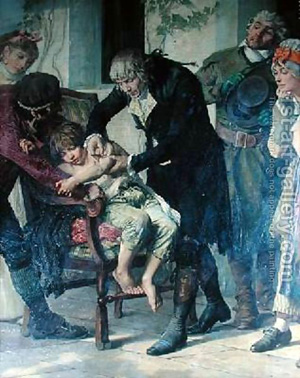Edward Jenner and vaccination
Smallpox was a terrible disease which killed millions of people. It disfigured and disabled millions more all over the world. In the 18th century 'the pox' was common in Britain – around 20% of all deaths were caused by smallpox.
Edward Jenner was a country doctor who worked with the farmers in Gloucestershire in the late 18th century. He noticed that the girls who milked the cows often caught cowpox, which gave them spots rather like smallpox spots on their hands. He also noticed that milkmaids rarely caught smallpox.
In the 18th century no-one knew how infectious diseases were spread or how the immune system works. However Jenner began to wonder if deliberately infecting people with cowpox might protect them against smallpox.
Finally in 1794 Jenner decided to try out his idea. He took pus from the cowpox spots of a milkmaid and scratched it into the skin of a healthy young boy called James Phipps, who then developed cowpox.

Edward Jenner
Two months later Jenner scratched pus from a smallpox victim into James's arm. The little boy showed no signs at all of the deadly infection. Jenner's idea met with quite a lot of opposition but in the end the technique was so successful that protecting someone against a serious illness by exposing them to a similar but mild illness became widely accepted. The technique was called vaccination to link it with Jenner's work on cowpox (the Latin word for cow is vacca!).
Even in the 1960s millions of people were still infected with smallpox worldwide and around 2 million people a year died. But a massive international vaccination programme meant that in 1980 the WHO declared that smallpox had officially been eliminated from the world. The virus is now stored in a small number of laboratories around the world, and children are no longer vaccinated against a disease which does not exist.
Interestingly, Jenner's work would not be allowed today – it would be completely unethical to use a healthy child in an experiment in this way!













